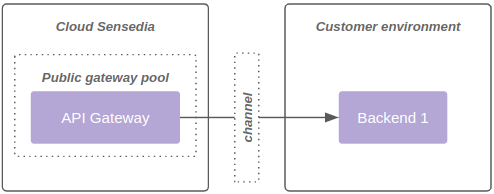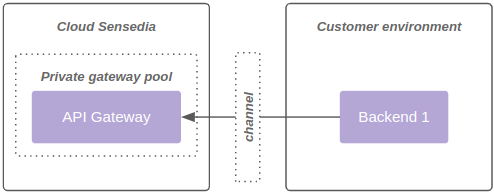Connectivity models
The data plane can be connected to private environments for:
1 - Backend consumption of the public gateway pool, as shown in diagram 1:

2 - Consumption of the private gateway pool, as shown in diagram 2:

| A gateway pool cannot be public and private at the same time. |
Supported connectivity models
-
Allow list (Default)
-
Positive aspects
-
Most recommended model due to practicality and resilience.
-
Each data plane has at least 2 fixed output IPs. These IPs can/should be used for customer-side firewall controls.
-
To further enhance security, an mTLS strategy can be used between the gateways and the backend.
-
Cost already included in standard offers.
-
-
Limitations
-
It is not possible to access backends without externalization through a proxy or similar technology.
-
-
The diagram below represents connectivity through Allow list:

-
VPN (on request)
-
Positive aspects
-
Model with private access.
-
-
Attention points
-
Shared responsibility.
-
The SLA is different for VPN environments, given the high incidence of problems.
-
Higher cost of configuration, maintenance and troubleshooting.
-
-
Limitations
-
Each data plane can be connected to up to 4 networks, limited to 8190 IPs.
-
Currently, BGP is not supported.
-
-
The diagram below represents connectivity through VPN:

-
VPC Peering (on request)
-
Positive aspects
-
Stability and resilience.
-
Simplified setup.
-
-
Attention points
-
Offer available only to customers whose backend is also allocated on AWS.
-
-
Limitations
-
Each data plane can be connected to up to 4 networks, limited to 8190 IPs.
-
-
The diagram below represents connectivity through VPC Peering:

-
Transit Gateway (on request)
-
Positive aspects
-
Possibility to access backends through a private link.
-
No need to use VPN.
-
Greater communication flexibility between VPCs.
-
Within AWS limits, regarding Transit Gateway and connectivity, essential points are adjustable.
-
For more information, see the AWS Transit Gateway Limits documentation.
-
-
Attention points
-
Customer must share AWS Transit Gateway using their Sensedia account.
-
Need to create routes on the Sensedia side and on the client side.
-
The AWS billing fee happens on both sides (Customer and Sensedia), as AWS charges per VPC attached to the AWS Transit Gateway, and it happens on both sides.
-
-
Limitations
-
Each data plane can receive up to 5 unique AWS Transit Gateway attachments.
-
AWS Transit Gateway limits also apply.
-
-
The diagram below represents connectivity through Transit Gateway:

| For more information on the process of establishing connectivity using AWS Transit Gateway, visit this link. |
-
Direct Connect (on request)
-
Positive aspects
-
Possibility to access backends through a private link.
-
-
Attention points
-
Cost.
-
Shared responsibility model between Sensedia, customer and link provider.
-
-
Limitations
-
Each data plane can be connected to up to 4 networks, limited to 8190 IPs.
-
-
The diagram below represents connectivity through Direct Connect:

| Networks above 8190 hosts (/19) are not supported. |
-
Private link (on request)
-
Positive aspects
-
Facilitates communication between components on AWS.
-
Ensures private access with high resiliency.
-
For more information, see official AWS documentation.
-
-
Negative aspects
-
Requires exposure through NLB on the customer side.
-
-
Private DNS name
-
As per the AWS documentation, it is possible to use a name with a custom domain (
<service>.customer.com.br, for example) in the endpoint service. This name is considered private because AWS registers it in a DNS zone local to the VPCs connected to the endpoint service. -
The advantage is being able to consolidate the service exposure under a unique name for different service consumers.
-
For customers wishing to use this functionality, it is necessary to enable and validate the endpoint service to use the selected name. Once configured, the customer must open a ticket with Sensedia support, requesting the activation of the private DNS name and providing the relevant endpoint service information.
-
-
Limitations
-
Up to 4 VPC endpoints (powered by AWS Private link) are supported per data plane.
-
-
The diagram below represents connectivity using VPC endpoint powered by AWS Private link:

Additionally, it is possible to use the same VPC endpoint associated with the same load balancer, with multiple ports and target groups. The diagram below represents this model:

Share your suggestions with us!
Click here and then [+ Submit idea]